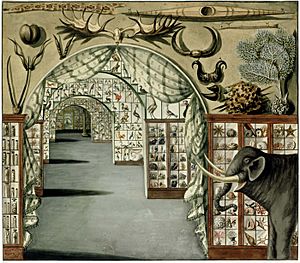Ashton Lever facts for kids
Quick facts for kids
Ashton Lever
|
|
|---|---|
 |
|
| Born | 5 March 1729 Alkrington Hall, England, Kingdom of Great Britain
|
| Died | 28 January 1788 (aged 58) Kingdom of Great Britain
|
| Occupation | British antiquarian |
Sir Ashton Lever (born 5 March 1729 – died 28 January 1788) was an English person who loved collecting things from nature. He was especially famous for his huge collection, which became known as the Leverian collection. He was also a Fellow of the Royal Society (FRS), which is a very old and respected group for scientists.
Contents
Who Was Sir Ashton Lever?
Sir Ashton Lever was born in 1729 at a place called Alkrington Hall in England. His father, Sir James Darcy Lever, was an important person in the local area, serving as the High Sheriff of Lancashire in 1735.
How Did His Collection Start?
Sir Ashton started his amazing collection around 1760 by gathering seashells. But he didn't stop there! He kept adding more and more natural objects, even live animals. His collection grew to be one of the biggest and best private collections of its time.
Opening His Museum
In April 1766, Sir Ashton decided to share his collection with everyone. He opened it to the public in Manchester. A few years later, in 1771, he moved the museum to his family home at Alkrington Hall, near Rochdale, Lancashire.
In the same year, he also helped start the Archers' Hall in London for a group called the Archers' Company. This shows he had many interests!
In 1774, Sir Ashton moved to London. The next year, his museum, which he called the Holophusicon, opened in Leicester Square. Even famous explorers like Captain James Cook were very impressed by Lever's collection. Captain Cook even gave items from his own travels to the museum!
What Happened to the Collection?
Sir Ashton loved collecting so much that he kept buying new items until he ran out of money and became bankrupt. At this point, his collection had an incredible 28,000 different items!
He tried to sell the collection, but neither the British Museum nor the Empress of Russia wanted to buy it. So, Sir Ashton decided to sell it through a lottery. People bought 8,000 tickets, each costing one guinea (an old type of coin).
The Lottery Winner
The lucky winner of the lottery was a man named James Parkinson. He later decided to sell the collection himself in 1806 through an auction. Many people bought parts of the collection. Some of the biggest buyers were the British naturalist Edward Donovan and Leopold von Fichtel, who was buying for the Natural History Museum, Vienna. Other important buyers included the Earl of Derby and William Bullock, who also had a large private collection of his own.
The entire collection was carefully listed and described by a scientist named George Shaw.
Images for kids



